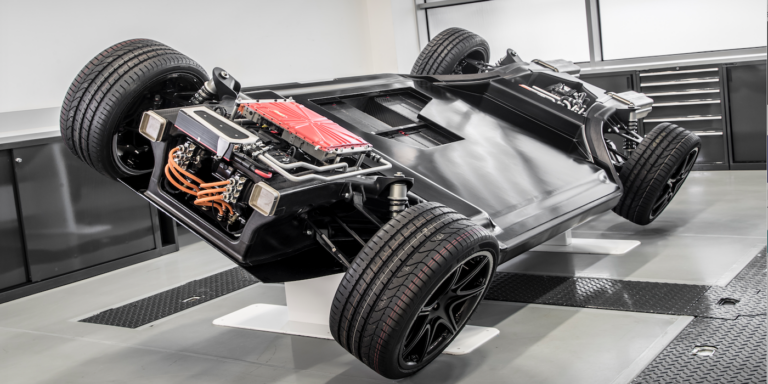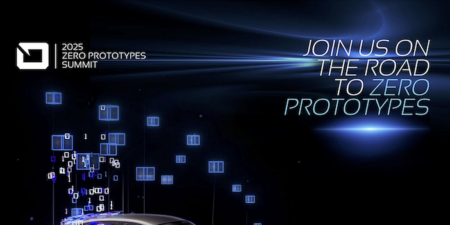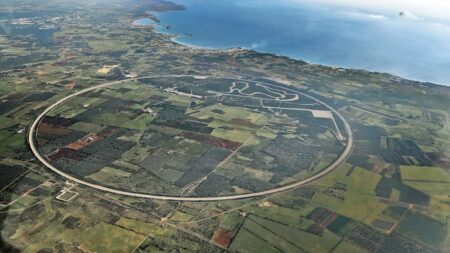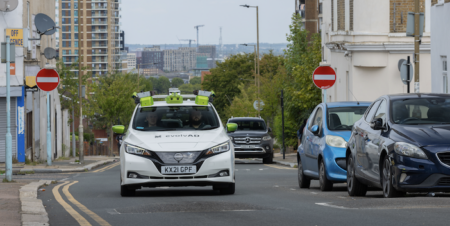Williams Advanced Engineering has developed an innovative electric vehicle platform concept. Named FW-EVX, the lightweight and compact chassis is readily scalable for C, C-D and D-segment vehicles. According to the company, in a typical C-segment application, the platform weighs 955kg, including an all-round wishbone suspension, up to four motors, a 4WD transmission and a steering system.
This weight also includes a 350kg, 80kWh lithium-ion battery pack, a high-strength module that contributes to the vehicle structure as the aluminum base plate is bolted directly to the thermally conductive vehicle floor.
The bonded aluminum and carbon composite center module of the FW-EVX platform includes chassis side rails that create controlled crush zones for impact absorption. These side rails serve a dual function, as they also provide cooling air for the battery pack, collected through ducts at the front of the vehicle, which helps minimize both the vehicle frontal area and the aerodynamic drag that can be created by heat exchangers. The sills channel cooling air through internal radiators then direct it toward the rear of the vehicle to create downforce via an aerodynamic diffuser.
Below: The sills channel cooling air through internal radiators and then direct it rearwards to create downforce via an aerodynamic diffuser
“The high level of integration creates a virtuous circle where each improvement in weight and functionality leads to additional benefits,” stated Paul McNamara, technical director at Williams Advanced Engineering. “For example, the weight saving permits increased battery capacity and greater vehicle range.”
There has been a strong focus on the use of composite materials in the design, with a view to making them more feasible in high-volume applications. For example, the suspension wishbones (pictured below) are press-formed from 80% recycled carbon composite using what the company describes as, “a highly automated, near zero waste process with a cycle time of just 90 seconds”. This process has been named Racetrak, and is claimed to create wishbones 40% lighter than conventional forged aluminum versions, yet comparable in cost.
Making 3D from 2D
Further composites innovation was applied in the battery module design, for which Williams Advanced Engineering devised a new technique in composite manufacture, inspired by its experience as the battery supplier to the FIA Formula E Championship.
“We have invented a method of creating an engineered hinge embedded in a single composite preform that allows 3D structures to be created from 2D materials then folded when required, called 223, and it opens up the potential to use new types of assembly processes alongside much lower cost, more flexible logistics,” McNamara explained.
This has enabled the central battery module of the FW-EVX to be a low, slim, ultra-stiff honeycomb of interlocking composite boxes containing the battery cells. Using the automated 223 process, each box is manufactured in sheet form, then folded and bonded to create the required shape. The company says that the resulting exo-skeleton contributes to the structural performance of the vehicle and provides enhanced safety systems, including crash protection and isolation.
Williams Advanced Engineering anticipates interest from two distinct customer groups for the FW-EVX technology: vehicle manufacturers looking for a next-generation EV platform that brings the benefits of highly integrated design, and those seeking specific areas of technology for their own platforms.
As McNamara added, “An electric vehicle constructed on the FW-EVX platform can be lighter, safer, greener and much more cost-effective. This potential performance would be greater even than a design adapted from a conventional vehicle or one assembled from individual state-of-the-art systems from technology suppliers. By designing the key systems as an integral part of an aluminum/composite vehicle chassis, we have greatly reduced many of the compromises that arise when the individual elements of an EV powertrain are sourced separately, forcing the vehicle architecture to be created around stand-alone packages.”





